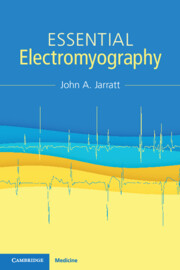There are few difficult concepts in clinical medicine. Rocket science it definitely is not. But the bewildering profusion of nomenclature is undoubtedly a barrier to the understanding of many disciplines, clinical neurophysiology included.
Clinical neurophysiology is the application of electronic techniques to the nervous system and its connections for the purposes of diagnosis, monitoring and, occasionally, treatment. This book deals only with electromyography (EMG) and nerve conduction studies (NCS) as used in diagnosis and monitoring.
As with all diagnostic methods, be they purely clinical, or investigative or a combination, a number of general questions need to be addressed. These are listed here together with the issues specific to clinical neurophysiology:
What is the location of the disorder? (Is it in muscle, nerve or the neuromuscular junction, and if in the nerve, is the condition local or widespread?)
What is the pathology? (If muscle is affected, can it be defined? If nerve is implicated, is it degenerating, in which the nerve fibre itself is involved, or is it demyelinating, in which the insulating sheath around the nerve is damaged?)
What is the severity and thus the prognosis? (What is the degree of change? And what is the likely clinical diagnosis and thus prognosis?)
Having identified an abnormality, can it be monitored?
We start by defining the scope of the book. The first part deals with basic elements of anatomy, physiology and technical matters in an effort to provide some simple but sufficient background material. The second part then describes the principles of the examination methods and how they are used in clinical practice.
Peripheral nerves carry nerve impulses from the skin via the dorsal root ganglion to the spinal cord and thence to other parts of the central nervous system. These are sensory nerves. Nerve impulses to a muscle are sent from an anterior horn cell within the grey matter of the spinal cord to the neuromuscular junction from where they are transmitted to the muscle fibres. These are motor nerves. Both types are shown in Diagram 1.1.

Diagram 1.1 An overview of the anatomical structures investigated by EMG and NCS.
Electromyography investigates disorders of neuromuscular transmission and also abnormalities within muscle arising from primary muscle disease or as a consequence of pathology within its nerve supply.
Nerve conduction studies are also used to investigate neuromuscular transmission. Their main function is to detect changes in peripheral nerves arising as a result of compression, or other forms of trauma, or systemic disease (Diagram 1.2).

Diagram 1.2 An overview of the application of EMG and NCS to diagnosis.
The summary table, Table 1.1, outlines the plan of the text showing how these techniques are used in the clinic to try and answer the diagnostic questions posed earlier.
Table 1.1 A summary table outlines the plan of the book. The book concludes with its completion.
| Anatomy | Pathology | Neurophysiology | |
|---|---|---|---|
| EMG | NCS | ||
| Muscle | Myopathy | ||
| Neuromuscular junction | MG | ||
| LEMS | |||
| Peripheral nervous system | D/M Neuropathy | ||
| |||
| D/G Neuropathy | |||
| |||
| AHC disease*** | |||
| Key to abbreviations: | |||
| |||
The completed table, Table 21.1, is given at the end of the book.




